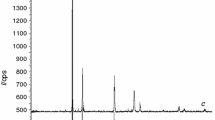Abstract
The oxide ion conducting systems Bi2O3-Y2O3-Pr6O11 and Bi2O3-Y2O3-ZrO2 have been prepared and studied in order to combine the advantages of stabilized Bi2O3 and ZrO2 solid electrolytes. Coprecipitation of high purity oxides was used for preparation. The formation of the fluorite-type cubic structure was confirmed by X-ray powder diffraction analysis. The relative contributions of ions and electrons to the total conductivity were measured by the concentration cell method.
Using Ultraviolet Photoemission Spectroscopy (UPS) we have determined the work function Φ of electrons, the position of the Fermi level in relation to the valence band edge (EF-EV) and the change of the ionization potential (I) as a function of temperature. For bismuth oxide-based solid electrolytes, we used an Fe/FeO mixture as reference contact to establish a defined oxygen partial pressure in the solid electrolyte sample.
Oxygen isotope exchange experiments were performed in an exchange cell with a gas regulating system and mass spectrometer to determine the oxygen surface exchange rate.
Similar content being viewed by others
5. References
W. Göpel, Techn. Messen52, 47, 92, 175 (1985).
P.T. Mosely and B.C. Tofield, Solid State Gas Sensors (Adam Hilger, Bristol-Philadelphia, 1987).
W.C. Mascell, J. Phys. E.:Sci. Instrum.20, 1156 (1987).
T. Seiyama, Chemical Sensor Technology, Vol. 1, 2 (Elsevier, Amsterdam-Oxford-New York-Oxford, 1988/1989).
W. Göpel, T.A. Jones, M. Kleitz, I. Lundström and T. Seiyama (eds.), Chemical and Biochemical Sensors, Vol.2/3 (VCH, Weinheim, 1991/1992).
T. Takahashi and H. Iwahara, Mat. Res. Bull. 13, 1447 (1978).
P. Shuk, A. Vecher and V. Samochval, Lett. of Byeloruss.Univ.1, 8 (1984) (in Russian).
P. Shuk, H.-D. Wiemhöfer, U. Guth und W. Göpel, Solid State Ionics, to be publ.
G. Mairesse, in: Fast Ion Transport in Solids, eds. B. Scrosati et al. (Kluver, Amsterdam, 1993) p. 271.
Y. Beresovskaya, I. Vasilieva and A. Maiorova, Lett. of Acad. Sci. SU (Moscow)301 (1988) 626 (in Russian).
A.J.A. Winnubst and A.J. Burggraaf, Mat. Res. Bull.19, 613 (1984).
A.J.A. Winnubst, A.H.A. Scharenborg and A.J. Burggraaf, Solid State Ionics14, 319 (1984).
M. Miyayama and H. Yanagida, Mat. Res. Bull.21, 1215 (1986).
M. Miyayama, T. Nishiand and H. Yanagida, J. Mater. Sci.22, 2624 (1987).
A. Vecher, P. Shuk, E. Naumovich and T. Khodorenko, Ion Melts and Solid Electrolytes (Kiev)4, 73 (1989) (in Russian).
P. Shuk and H.-H. Möbius, Z. physik. Chem. (Leipzig)266, 9 (1985).
W. Göpel, Sensors and Actuators16, 167 (1989).
W. Göpel and H.-D. Wiemhöfer, Ber. Bunsenges. Phys. Chem.94, 981 (1990).
V. Kharton and E. Naumovich, J. Electrochem. (Moscow)29, 1481 (1993) (in Russian).
P. Shuk, E. Naumovich, A. Vecher and A. Bumblis, Ion Melts and Solid Electrolytes (Kiev),5, 77 (1990) (in Russian).
P. Shuk, S. Jakobs and H.-H. Möbius, Z. anorg. allg. Chem.524, 144 (1985).
M.J. Verkerk, K. Keizer and A.J. Burggraaf, J. Appl. Electrochem. 10, 81 (1980).
H.-D. Wiemhöfer, S. Harke and U. Vohrer, Solid State Ionics40/41, 433 (1990).
P. Shuk, H.-D. Wiemhöfer and W. Göpel, Solid State Ionics, in press (1995).
E. Kurumchin, G. Vdovin, G. Gorelov, P. Shuk and E. Naumovich, in: Solid State Ionics, ed. M. Perfiliev (Nauka, Ekaterinburg, 1993) p. 39 (in Russian).
Author information
Authors and Affiliations
Rights and permissions
About this article
Cite this article
Shuk, P., Wiemhöfer, H.D., Guth, U. et al. New solid electrolytes based on bismuth oxide. Ionics 2, 46–52 (1996). https://doi.org/10.1007/BF02375868
Received:
Issue Date:
DOI: https://doi.org/10.1007/BF02375868




